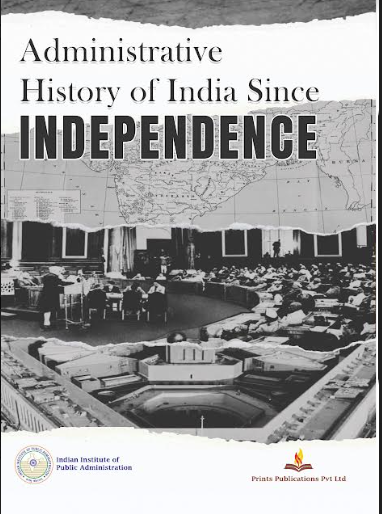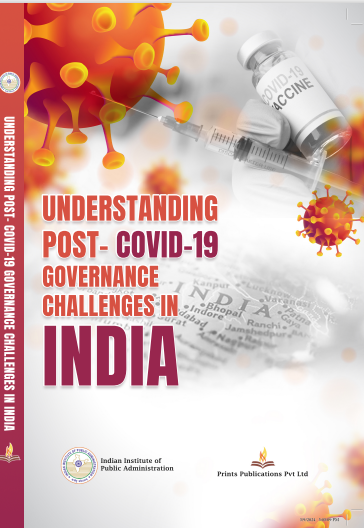| Publisher | Prints Publications Pvt Ltd |
| Publication Year | 2024 |
| ISBN-13 | 9788119972005 |
| Binding | Hard back |
| Number of Pages | 329 Pages |
| Language | English |
| Edition | 1st |
| Dimension (Inches) | 26.3 x 20.2 x 2 |
| Subject | Public Administration |
| Category | Government & Politics |
| Contents | |
| Background | 1 |
| Post Independence: Institutional Building Phase | 4 |
| Constitution of India: Building Block of Modern India | 4 |
| Preamble: Guarantee To Protect Social & Economic Security of Citizens | 5 |
| Integration of Princely States Ushered Nation in One | 5 |
| Vitality of Fundamental Rights and Directive Principles of State in Democratic Nation | 6 |
| Federal System of India Determine the Administrative Harmon | 7 |
| Parliamentary Democracy Ensures Administrative Accountabilit | 9 |
| The Cabinet as Pinnacle of Administrative System | 9 |
| Cabinet Secretariat Maintains Coherence in Execution of Policies | 10 |
| Essential Decision Making Under Cabinet Committees | 11 |
| Crucial Role Prime Minister’s Office in Government | 11 |
| Secretariat Serves as Operational Centre for Ministries and Departments | 12 |
| A D Gorwala Committee Report (1951) Formed to Evaluate the Implementation Initiatives | 12 |
| How Paul H Appleby 's Report s enhance administrative operations and exercises | 13 |
| Planning Commission Amplified Nation’s Material Resources and Productivity | 13 |
| Finance Commission Imposes Financial Health of Nation | 14 |
| Pay Commission: Structure Duties and Compensation for Government Employees | 15 |
| National Development Council: Symbol of Federal Planning | 15 |
| Administrative Reform Commission 1966 Evolve Methodical Public Administration System | 16 |
| Developing Unity and Integrity Through Building Centre - State Relation | 17 |
| Lokpal and Lokayukta for Effective Remedial System for Corruption | 19 |
| Emergence of Local Government: Distribute Authority and Decision Making | 20 |
| Emergency Provision Protect Nation’s Sovereignity, Unity and Integrity | 24 |
| Constitutional Bodies Promote Efficiency of Government | 31 |
| Liberalization Phase In 1991 as Renaissance of Indian Economy | 32 |
| New Economic Policy 1991: Remove the Economic Rigidity in the Nation | 34 |
| Territorial Organization of States: To Foster Linguistic and Cultural Unity | 36 |
| Background | 36 |
| Linguistic Commission: Advances Geographic Continuity for Future Expansion | 36 |
| District Administration Serves as Boon at Federal Level | 41 |
| Urban Local Bodies: Strong Hold on Governance of Cities | 47 |
| Municipal Personnel System: Promotes Local Autonomy | 48 |
| Municipal Revenue: Magnitude of Taxes | 49 |
| Apparatus for Capacity Building Period | 50 |
| How Power Expands by Accountability | 50 |
| Pesa Act 1996 Strengthens the Autonomous States | 52 |
| Accountability Ecosystem of Institutions | 52 |
| Significance of Bureaucracy in India | 54 |
| Public Services Upholding National Integrity | 56 |
| Amalgamation of Strong Executive and Laws: Necessary for Sustainability of Administration | 60 |
| Reforms Phase From 1947 - 2013 | 62 |
| Reform Phase: After Independence | 62 |
| Reform Phase: Early 1990s | 70 |
| Reform Phase initiated in 1991 as LPG Theory | 70 |
| Reform Phase: UPA Government | 74 |
| Administrative Reform Commission 2005 Strengthen the Administrative Capacity | 85 |
| During Manmohan Administration Policy Failure: Policy Paralysis | 90 |
| Revival of Policies | 92 |
| Lateral Entry Reform for Increasing Bureaucratic Efficiency | 93 |
| How Lateral Entry Is Breaking Bureaucratic establishment | 93 |
| Indian Institute of Public Administration Trained the Lateral Entry Candidates | 94 |
| IIPA and its Capacity Building to Generate Specialist | 95 |
| Capacity Building Commission Promoting Civil Services Capacity | 97 |
| National Programme Capacity Building – Mission Karmayogi | 98 |
| Karmayogi Bharat | 102 |
| Recruitment Reforms to Enhance Equal Opportunity in Hiring Process | 102 |
| National Recruitment Agency Manages to Simplify Examination Process | 103 |
| Tenure Based Hiring as Inventory Hiring Process | 104 |
| Agnipath Scheme | 105 |
| Human Management in Public Sector to Improve the Governance Efficiency | 106 |
| Human Manager as Administrator to Optimize the Administrative Tasks | 107 |
| Changing Role of Personnel Management to Boost the Employee Engagement | 107 |
| Recruitment Agencies Require to Diverse Hiring Process | 108 |
| Union Public Service Commission Brings Advances in Recruitment Process | 109 |
| Administrative Tribunal Ensure Protection for Government Employees | 111 |
| Strategies to Make Bureaucracy Accountable | 113 |
| Niti Aayog as Consultant Helps to Bring Reforms | 115 |
| Decentralization V/S Centralization Debate | 117 |
| Committees for Centre – States Relations to Consolidate National Unity | 121 |
| Cooperative Federalism Invigorates the Governance | 121 |
| GST Council as Federal Innovation | 122 |
| Regulatory Bodies Enforce Accountability to Maintain Laws | 124 |
| Advent of NDA Government | 129 |
| 9 Years of Modi Government: Policy Initiatives | 131 |
| Government Approach to Integrate Entire Nation in one | 135 |
| Ek Bharat Shreshtha Bharat: Promoting Unity in Diversity | 135 |
| Mann ki Baat | 138 |
| 100th Episode of Mann ki Baat | 139 |
| Swacchh Bharat Mission | 140 |
| Celebration Of 75 Years of Independence: Har Ghar Tiranga | 142 |
| International Yoga Day: Consolidation of Nations for Yoga Under Modi Government | 143 |
| Sabka Sath Sabka Vikas | 144 |
| Digital India: Transforming the Nation | 146 |
| National Digital Communication Policy (NDCP) 2018 | 148 |
| Make in India Promoting India as Global Manufacturer | 153 |
| Sector Wise Make in India Policy | 154 |
| One Proof for Identification: Promote Simplification of Rules | 157 |
| Merger of Banks | 163 |
| Constitutional Amendments under Modi Government | 164 |
| Modi Government’s Reforms in Education Sector | 172 |
| PM Shri School | 177 |
| Healthcare Reform Initiatives Under Modi Government | 179 |
| Financial Sector Reforms: Initiatives by Modi Government | 185 |
| Foreign Policy Strategies Under Modi Government to Achieve Economic Strength for India | 192 |
| Economic Core Momentum Build up by Modi Government | 193 |
| Merger of Ministries and Departments by Modi Government | 194 |
| Modi Government Advancements for Space Sector | 196 |
| Modi Government Initiatives to Propel Energy Capacity in India | 197 |
| Development in Science & Technology Sector | 200 |
| Consumer Protection Measures Under Modi Government | 202 |
| G – 20 Summit in India 2023 | 204 |
| Modi Government Action to Increase the Productivity in Agriculture Sector | 205 |
| Infrastructure Development by Modi Government to Expand Modernization | 208 |
| Environment Friendly Policies Introduced by Modi Government | 215 |
| Modi Government Expand Cultural Diversity | 217 |
| Defence and Military Strength Under Modi Government | 219 |
| CoWIN: Strength to Control Global Pandemic in India | 223 |
| Vande Bharat Mission | 224 |
| Government Ensured Policies & Services to manage Covid | 224 |
| Anubhav | 229 |
| References | 231 |
| List of Tables | |
| Table 1: Territory of India in 1950s | |
| Table 2: Territory of India (After State Reorganisation Act, 1956) | |
| Table 3: 2nd Administrative Reforms | |
| Table 4: Accumulation of dosage delivery covering entire country | |
| List of Figures | |
| Figure 1: Local Self-Government Before independence | |
| Figure 2: Difference between 42nd and 44th Amendment Act | |
| Figures3: Framework of three tier system | |
| Figure 4: Autonomous District Councils in 4 States | |
| Figures 5: Exempted States & Areas for Panchayat | |
| Figure 6: Training Approach at IIPA | |
| Figure 7: Training Design Pattern at IIPA | |
| Figure 8: Mission Karmayogi Structure | |
| Figure 9: Pre Independence-Decentralization Debate | |
| Figure 10: Post Independence Decentralization Debate | |
| Figure 11: Decentralization Structure of India | |
| Figure 12: Central Government Structure of Decentralization | |
| Figure 13: Taxes out of GST | |
| Figure 14: Svamitva Card | |
| MAP: Autonomous Division of India | |
| Annexure 1: Bureaucrats’ ANUBHAV during their Service – 2021 | |
| Annexure 2: Bureaucrats’ ANUBHAV during their Service – 2022 | |
| Annexure 3: Bureaucrats’ ANUBHAV during their Service – 2023 |
Products related to this item

Best Prices
100% money back

Fast Shipping
Orders over $500

Buyers Protection
Loreum Ipsum Text

Live Support
24/7 Help & Support











